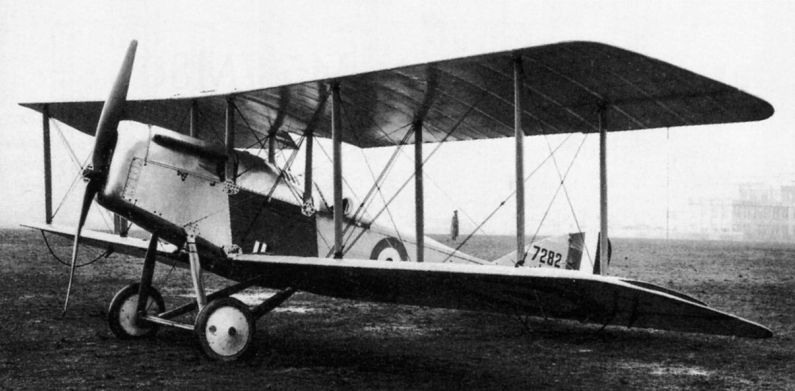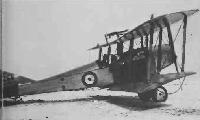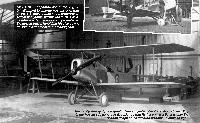
Описание
Страна : Великобритания
Год : 1915
Одноместный истребитель
Martinsyde G.100 и G.102 Elephant
Летом 1915 года компания "Martinsyde" спроектировала вооруженный разведывательный биплан G.100, улучшенный и больший по размерам, чем F.1. Прототип выполнил первый полет в сентябре того же года. Такие размеры понадобились для обеспечения 5-часовой продолжительности полета, необходимой для сопровождения разведывательно-рекогносцировочных двухместных машин. Самолет G.100 с мотором Beardmore мощностью 120 л. с. (89 кВт) впервые применили на Западном фронте в начале 1916 года. Эти машины поставляли эскадрильям в небольшом количестве. Во Франции одноместный самолет за свои размеры получил прозвище "Elephant" (слон). Одними G.100 вооружили лишь 27-ю эскадрилью, по ассоциации с прозвищем самолета на ее эмблеме появилось слоновье ухо. В конце 1916 года вслед за самолетом G.100 выпустили улучшенный G.102 с более мощным мотором Beardmore, способным поднимать и увеличенную полезную нагрузку. Благодаря этому самолет нередко использовали в качестве бомбардировщика. Развитием машин G.101/102 стал одноместный истребитель-биплан RG с мотором Rolls-Royce Falcon мощностью 190 л. с. (142 кВт). Первые официальные испытания RS состоялись в начале 1917 года, самолет показал хорошие летные данные, но в серию не пошел из-за дефицита моторов Falcon, приоритет на которые получил другой самолет - Bristol Fighter.
ТАКТИКО-ТЕХНИЧЕСКИЕ ХАРАКТЕРИСТИКИ
Martinsyde G.102
Тип: одноместный истребитель
Силовая установка: один мотор жидкостного охлаждения Beardmore мощностью 160 л. с. (119 кВт)
Летные характеристики: максимальная скорость на высоте 610 м - 167 км/ч; практический потолок 4875 м; продолжительность полета 4 ч 30 мин
Масса: пустого 813 кг; максимальная взлетная 1115 кг
Размеры: размах 11,58 м; длина 8,23 м; высота 2,95 м; площадь крыльев 38,09 м2
Вооружение: два 7,7-мм пулемета Lewis (один стреляющий вперед над верхним крылом и один для обстрела задней полусферы за кабиной), до 118 кг бомб на внешних подвесках
Описание:
- Martinsyde G.100 и G.102 Elephant
- Flight, June 1920
THE MARTINSYDE MACHINES
Фотографии
-
Мировая Авиация 185
Регистрационный номер: 7282 Всего построили 300 истребителей Martinsyde G.100/102 Elephant. 133 из них поступили в эскадрильи на Западном фронте, 64 - на Ближний Восток, оставшиеся распределили между дислоцированными в Великобритании учебными частями.
-
Flight 1920-06 / Flight
Регистрационный номер: A6289 [2] The Martinsyde G.100, 160 h.p. Beardmore engine
-
Aeroplane Monthly 1983-03 / A.Curtis - Memoirs of an early bird (1)
Регистрационный номер: A6289 [2] A Martinsyde G.102 Elephant seen at Brooklands. A6289 was a presentation aircraft, named Mount Lofty, South Australia, and presented to the RFC by Mrs H. Bickford. Designed at the outset as a single seat fighter, it was more effectively employed as a bomber by way of its good loading capability. The author recalls that Elephants floated horribly. The G.102 was powered by the 160 h.p. Beardmore engine.
-
Aeroplane Monthly 1979-12 / R.Brett - Schoolboy Memoires
Регистрационный номер: A6299 Elephant A6299 outside the Martinsyde test depot, Brooklands, 1916.
-
Air Pictorial 1955-09 / J.Bruce - The Martinsyde Elephant /Aeroplanes of 1914-18 War/
Martinsyde G.100 Elephant
-
Air International 1985-11 / Fighter A to Z
Регистрационный номер: A1592 The G.102 higher-powered version of the Martinsyde Elephant which succeeded the G.100.
-
Aviation Historian 1
The first photograph of the single-bay Elephant to emerge was this one, with a young Sydney Camm in the foreground. Camm had joined Martinsyde in 1914 as a woodworker but he was soon promoted to the design office, heralding his rise as one of Britain’s foremost aircraft designers.
-
Aviation Historian 1
The newly-emerged photograph of the single-bay Elephant shows it standing in the Martinsyde hangar at Brooklands with its tail on a trestle. It is only the second image of the obscure machine to come to light.
-
Air Enthusiast 1997-03 / A.Thomas - More from Mesopotamia
The G.100 Elephant ‘Baksheejh’, with 30 Squadron, 1917. This ‘aircraft’ was made from spare parts, hence the name (Arabic for 'free') that appeared in lieu of the serial number.
-
Aeroplane Monthly 1983-04 / Skywriters
Early gunsights on a Martinsyde Elephant, 1916. The rectangular backsight is at left, partly obscured by the rear centre-section strut.
-
Air Enthusiast 1998-07 / D.Nicolle - Young Turks (3)
The Martinsyde G100 Elephant captured by the Turks in Iraq and then recaptured by the British at Tikrit. It has been given Ottoman Air Force markings but retained its RFC serial number. Though listed at the Mosul Aircraft Park it probably served as a decoy at Tikrit aerodrome. Apparently the British tried to drag the Martinsyde G100 away using an armoured car.
-
Air Enthusiast 1998-07 / D.Nicolle - Young Turks (3)
Not surprisingly, given the fact that the Martinsyde G100 no longer had any wheels, the British efforts to drag it away resulted in the machine finally collapsing with a broken back!
-
Air International 1985-11 / Fighter A to Z
The initial production version of the Martinsyde Elephant, the G.100.
- Фотографии














